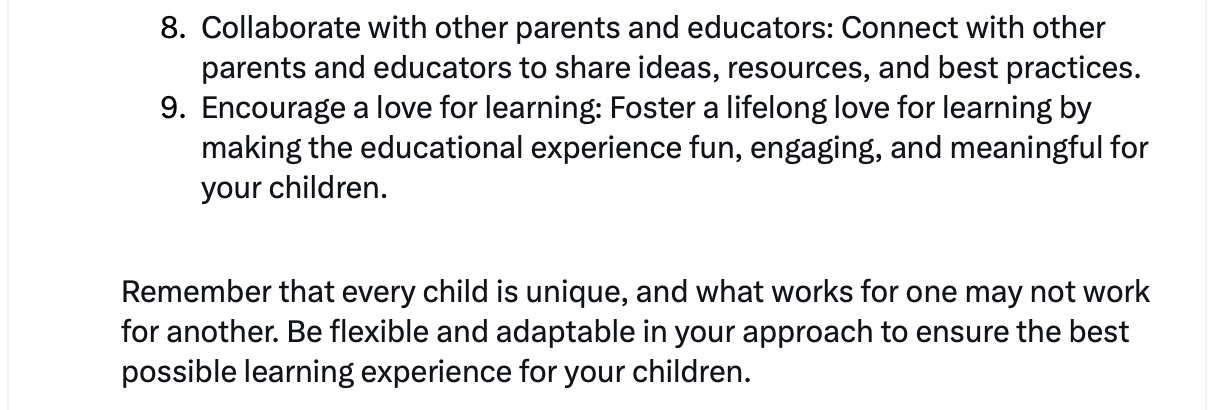Collaborating With Grok, ChatGPT,& Claude AI to Define a Modern Educational System
Getting The Ball Rolling
June 2023 was my final month as an educator after fifteen years. I hung up the gloves. It was time for the next adventure.
July 2023, Learning Producers, Inc. is founded by yours truly. It is a startup that embraces AI tools to pioneer novel educational pathways.
Now, March 2024, I’ll quote the philosopher, Duke Nukem; who wisely stated, “It’s time to kick ass and chew bubblegum.”
Q1: I want to help build a more modern educational learning model for my country, will you help me?
My first attempt brainstorming with my AI buddies on what exactly is at the core of a more "modern" approach to educating the youth of the future
Different AI, Different Vibe
I noticed Grok first described the structure in which the current public educational model operates. Meanwhile, Chat GPT and Claude dove right in and began to lay some groundwork for possible ways to improve it.
After Question 1, I realized I had to create the context by which I wanted to frame our discussion. The vision needed more clarity.
Q2: My vision that I want to actualize is the following: Design and implement an educational learning system in a physical environment that I could trust to guide my own son and daughter- Do you understand this vision and can you assist me in making it a reality?
Claude suggesting my efforts are probably more ambitious than admirable (haha)!
Chat GPT allows you to add specific information to its knowledge base as well in order to draw more nuanced responses.
I prefer Grok in fun mode, because if you're not having fun what's the point?
Human Power
Here, I noticed that the fundamental human needs of the child was not the initial starting point of their responses. They first either mentioned planning objectives or designing curriculum. (Still, their approaches did contain important and health related elements such as parent engagement and continuous improvement.) I recognize this is where some of the AI capabilities are limited, as expected; it is a tool, not an authority on the human experience.
So what do we do at this juncture? Some may argue we are discussing education not healthcare or learning not parenting and babysitting. However, if you have enough discussions with adults working in schools, they’ll share that often hurdles to student progress are actions that happen before the child enters the class. Therefore, its relevance and value cannot be overlooked.
Brainstorming with my AI friends has led us to finally establish a definition of a possible “modern educational learning model” of the future:
A modern educational model has 3 concepts at its core:
The learner is a human being with irreducible needs and the environment must prioritize an awareness on making sure those needs are being met.
The community, parents, and learners collaborate to establish the needs and wants of their intellectual and physical growth.
Groups of adults guide groups of learners in open transparent spaces; the responsibility is shared by cohorts of trusted, accountable partners.
Despite being a simple definition, it is already vastly different than the status quo which is:
If the learner is not prepared on arrival it is overlooked in favor of academic instruction (which usually leads to disengagement).
The districts and administrators decide what and how intellectual growth is to be developed (educators fall in line or develop better approaches on their own time, leading to burnout).
One adult is usually in charge of a large group of learners isolated in a closed space and single handedly responsible for facing challenges that require additional compassionate human involvement.
I base this definition on the expertise and scientific knowledge of Dr. Gabor Mate who states:
“The fundamental basic needs of every child include nutrition, physical security, and consistent emotional nurturing. While nutrition and shelter are usually met in industrialized societies, emotional nurturing is often the need most likely to be disrupted. Emotional nurturance is crucial for healthy neurobiological brain development, with human connections creating neuronal connections. A child needs to be in a reliable, protective, and psychologically present attachment relationship with at least one adult to foster proper development.”
Also, the framing around “irreducible” needs is well organized by psychologist, Dr. Gordon Neufield.
Neufield believes there are four such needs:
The attachment relationship, a sense of connection to the child's caregiver.
A sense of security which allows the child to relax, instead of continually striving for approval.
Permission to feel such emotions as pain, sadness, grief and anger.
The experience of free play, which is necessary for development.
Although, it’s not the educator’s responsibility to provide those four needs, simply being aware of them will influence the adult learner’s approach when working with the child learner. This I believe is a great starting point to uncover possibilities for a more modern educational model. One where the human is seen first, then the learner.





